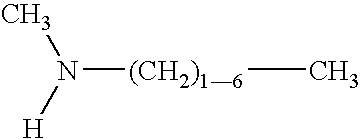Fuel additive formulation and method of using same
a technology of additives and fuel, applied in the direction of fuel additives, liquid carbonaceous fuels, fuels, etc., can solve the problems of ethanol-based fuel formulations that have not delivered the desired combination of increased performance, reduced emissions, and environmental safety, and achieve enhanced miscibility of nitroparaffins, preventing burning, and reducing friction
- Summary
- Abstract
- Description
- Claims
- Application Information
AI Technical Summary
Benefits of technology
Problems solved by technology
Method used
Image
Examples
example 2
[0145] Indolene was blended with EChem. The Indolene was the standard reference fuel, of Example 1, above. The EChem formulation used in testing the present invention was obtained from Don Young. The EChem formulation was prepared by: combining 1 gallon of commercially available Mobil Jet II Oil and 5 gallons of toluene in an epoxy-lined steel drum that had been flushed; allowing the toluene / ester oil mixture to stand for 10 minutes; adding 10 gallons of nitromethane; adding 10 gallons of nitroethane; adding 29 gallons of 1-nitropropane; and aerating the ingredients through a narrow tube at low pressure, and ambient temperature; to produce the additive. The EChem additive was added to Indolene at a rate of 0.1 oz. per gallon of fuel.
example 3
[0146] The MAZ 100 formulation of the present invention was prepared as follows:
[0147] 1. An epoxy-lined 55 gallon drum was flushed;
[0148] 2. 1 gallon of ester oil (modified Mobil Jet II Oil, without the tricresyl phosphate additive) was added;
[0149] 3. 5 gallons of toluene were added;
[0150] 4. The ester oil and toluene were allowed to stand 10 minutes at ambient temperature and pressure;
[0151] 5. 10 gallons of nitromethane were added to the mixture;
[0152] 6. 10 gallons of nitroethane were added to the mixture;
[0153] 7. 29 gallons of 1-nitropropane were added to the mixture;
[0154] 8. The components were mixed by gentle aeration, through a narrow tube at low pressure, at ambient temperature, venting the mixing vessel to ambient atmospheric pressure;
[0155] 9. The MAZ 100 additive formulation was then stored until needed for testing;
[0156] 10. The additive was mixed with a reference motor fuel (indolene), at a concentration of 0.1 oz. of MAZ 100 additive per gallon of Indolene (0.07812...
example 4
[0157] Indolene was procured as noted above in Example 1, from Phillips Chemical Company. MBE was added at 11%.
PUM
| Property | Measurement | Unit |
|---|---|---|
| volume percent | aaaaa | aaaaa |
| volume percent | aaaaa | aaaaa |
| volume percent | aaaaa | aaaaa |
Abstract
Description
Claims
Application Information
 Login to View More
Login to View More - R&D
- Intellectual Property
- Life Sciences
- Materials
- Tech Scout
- Unparalleled Data Quality
- Higher Quality Content
- 60% Fewer Hallucinations
Browse by: Latest US Patents, China's latest patents, Technical Efficacy Thesaurus, Application Domain, Technology Topic, Popular Technical Reports.
© 2025 PatSnap. All rights reserved.Legal|Privacy policy|Modern Slavery Act Transparency Statement|Sitemap|About US| Contact US: help@patsnap.com



